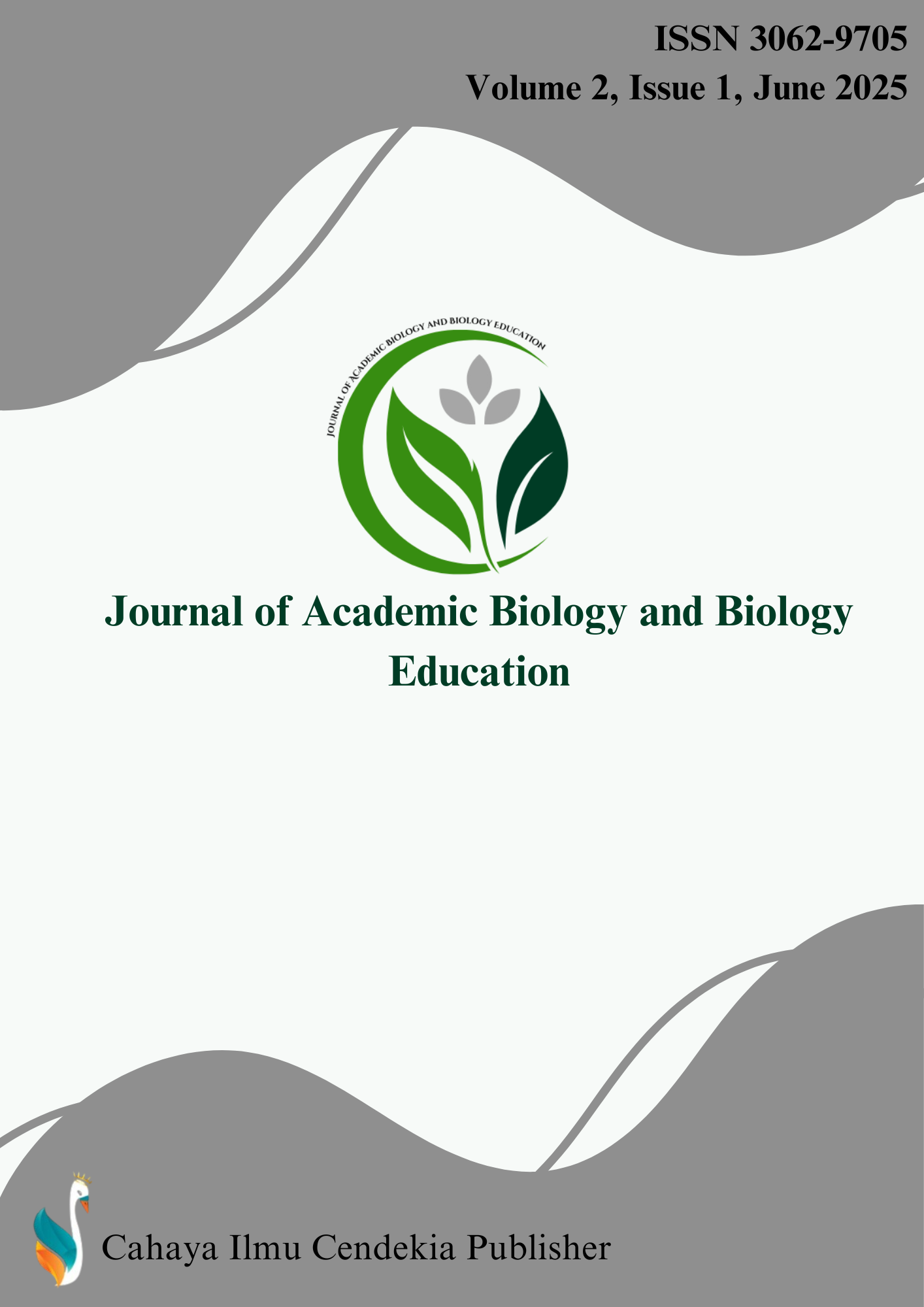Cardiometabolic Effects of Sus barbatus Meat Consumption: Analysis of Blood Cholesterol Levels and Cardiac Histopathological Alterations in Mus musculus
Abstract
Purpose of the study: This study aims to determine the effects of pork (Sus scrofa domesticus) and beef (Bos taurus) consumption on total cholesterol levels and the histopathological structure of the heart in male ICR mice (Mus musculus).
Methodology: This study employed an experimental laboratory design using a Completely Randomized Design (CRD). Fifteen male ICR mice (Mus musculus), aged 2–3 months and weighing 25–30 g, were divided into control, pork-fed (Sus barbatus), and beef-fed (Bos taurus) groups. After 30 days of treatment, blood samples were analyzed for total cholesterol levels, and heart tissues were examined histologically using the Hematoxylin-Eosin (HE) staining method. Data were analyzed statistically using SPSS.
Main Findings: Pork consumption increased total cholesterol in male ICR mice to 704 mg/dL. Beef-fed mice showed moderate cholesterol levels (319–321 mg/dL), while the control remained normal (114 mg/dL). Heart weight was highest in the pork group (0.25 g). Histopathology revealed fat cell accumulation only in pork-fed mice, with normal heart structures in both control and beef-fed groups.
Novelty/Originality of this study: This study uniquely investigates the direct impact of pork consumption on total cholesterol levels and cardiac histopathology in male ICR mice. It provides new evidence of fat accumulation in heart tissue due to pork intake, contributing to early detection of dietary-induced cardiac risks and expanding current understanding of food-based cardiovascular effects in animal models.
References
D. Ambroselli et al., “New advances in metabolic syndrome, from prevention to treatment: the role of diet and food,” Nutrients, vol. 15, no. 3, 2023, doi: 10.3390/nu15030640.
S. I. S. Rattan and G. Kaur, “Nutrition, food and diet in health and longevity: we eat what we are,” Nutrients, vol. 14, no. 24, pp. 1–7, 2022, doi: 10.3390/nu14245376.
N. E. Marshall et al., “The importance of nutrition in pregnancy and lactation: lifelong consequences,” Am. J. Obstet. Gynecol., vol. 226, no. 5, pp. 607–632, May 2022, doi: 10.1016/j.ajog.2021.12.035.
M. Esposito et al., “Insoluble residues from soybean, rice, oat and almond -based beverage: Landscape of the product category, chemical characterisation and valorization in the food industry,” Trends Food Sci. Technol., vol. 152, p. 104669, 2024, doi: 10.1016/j.tifs.2024.104669.
P. W. Harlina et al., “Lipidomics: a comprehensive review in navigating the functional quality of animal and fish products,” Int. J. Food Prop., vol. 26, no. 2, pp. 3115–3136, 2023, doi: 10.1080/10942912.2023.2252622.
C. O. R. Okpala and M. Korzeniowska, “Understanding the relevance of quality management in agro-food product industry: From ethical considerations to assuring food hygiene quality safety standards and its associated processes,” Food Rev. Int., vol. 39, no. 4, pp. 1879–1952, 2023, doi: 10.1080/87559129.2021.1938600.
G. Siemiński et al., “Meat nutritional value of puławska fattening pigs, polish large white × puławska crossbreeds and hybrids of danbred,” Animals, vol. 13, no. 15, pp. 1–11, 2023, doi: 10.3390/ani13152408.
I. Chernukha et al., “Pork fat and meat: a balance between consumer expectations and nutrient composition of four pig breeds,” Foods, vol. 12, no. 4, 2023, doi: 10.3390/foods12040690.
A. Brumm, “Pigs as pets: early human relations with the sulawesi warty pig (Sus celebensis),” Animals, vol. 13, no. 1, 2023, doi: 10.3390/ani13010048.
S. S. Q. Rodrigues, L. Vasconcelos, A. Leite, I. Ferreira, E. Pereira, and A. Teixeira, “Novel approaches to improve meat products’ healthy characteristics: a review on lipids, salts, and nitrites,” Foods, vol. 12, no. 15, pp. 1–18, 2023, doi: 10.3390/foods12152962.
A. D. Carboni, T. Di Renzo, S. Nazzaro, P. Marena, M. C. Puppo, and A. Reale, “A comprehensive review of edible flowers with a focus on microbiological, nutritional, and potential health aspects,” Foods, vol. 14, no. 10, 2025, doi: 10.3390/foods14101719.
R. Barthwal, S. Jain, P. Maurya, and M. K. P., “Meat Products with Low Cholesterol BT - Healthier Meat Products,” A. Kumar Pathera, H. Kumar, and S. Yadav, Eds., Cham: Springer Nature Switzerland, 2025, pp. 313–329. doi: 10.1007/978-3-031-78215-2_15.
C. R. D. Joseph Mercola, “Linoleic acid : a narrative review of the effects of increased chronic disease,” Nutrients, vol. 15, no. 3129, 2023, doi: 10.3390/nu15143129.
S. U. Islam, M. B. Ahmed, H. Ahsan, and Y. S. Lee, “Recent molecular mechanisms and beneficial effects of phytochemicals and plant-based whole foods in reducing ldl-c and preventing cardiovascular disease,” Antioxidants, vol. 10, no. 5, 2021, doi: 10.3390/antiox10050784.
R. S. Najjar, “The impacts of animal-based diets in cardiovascular disease development: a cellular and physiological overview,” J. Cardiovasc. Dev. Dis., vol. 10, no. 7, 2023, doi: 10.3390/jcdd10070282.
H. Liang et al., “A high-fat diet and high-fat and high-cholesterol diet may affect glucose and lipid metabolism differentially through gut microbiota in mice,” Exp. Anim., vol. 70, no. 1, pp. 73–83, 2021, doi: 10.1538/expanim.20-0094.
Y. Nie and F. Luo, “Dietary fiber: an opportunity for a global control of hyperlipidemia,” Oxid. Med. Cell. Longev., vol. 2021, 2021, doi: 10.1155/2021/5542342.
C. Giromini and D. I. Givens, “Benefits and risks associated with meat consumption during key life processes and in relation to the risk of chronic diseases,” 2022. doi: 10.3390/foods11142063.
C. Caiati, A. Stanca, and M. E. Lepera, “Free radicals and obesity-related chronic inflammation contrasted by antioxidants: a new perspective in coronary artery disease,” Metabolites, vol. 13, no. 6, 2023, doi: 10.3390/metabo13060712.
S. Sood, N. Mittal, T. G. Singh, and S. Devi, “Pathogenesis of obesity-associated cardiovascular diseases: key role of biomolecules,” Heal. Sci. Rev., vol. 7, p. 100098, 2023, doi: 10.1016/j.hsr.2023.100098.
R. Kumar, N. Chhillar, D. S. Gupta, G. Kaur, S. Singhal, and T. Chauhan, “Cholesterol homeostasis, mechanisms of molecular pathways, and cardiac health: a current outlook,” Curr. Probl. Cardiol., vol. 49, no. 1, Part B, p. 102081, 2024, doi: 10.1016/j.cpcardiol.2023.102081.
N. W. S. Chew et al., “The global burden of metabolic disease: data from 2000 to 2019,” Cell Metab., vol. 35, no. 3, pp. 414-428.e3, Mar. 2023, doi: 10.1016/j.cmet.2023.02.003.
D. Mohajan and H. K. Mohajan, “Obesity and its related diseases: a new escalating alarming in global aealth,” J. Innov. Med. Res., vol. 2, no. 3, pp. 12–23, 2023, doi: 10.56397/jimr/2023.03.04.
E. Gusev and A. Sarapultsev, “Atherosclerosis and inflammation: insights from the theory of general pathological processes,” Int. J. Mol. Sci., vol. 24, no. 9, 2023, doi: 10.3390/ijms24097910.
R. K. Upadhyay, “High cholesterol disorders, myocardial infarction and its therapeutics,” World J. Cardiovasc. Dis., vol. 13, no. 08, pp. 433–469, 2023, doi: 10.4236/wjcd.2023.138040.
M. S. Jahan, M. I. Haque, M. Gautam, and M. E. R. Bhuiyan, “Comparative analysis of high-fat diets: effects of mutton, beef, and vegetable fats on body weight, biochemical profiles, and liver histology in mice,” Heliyon, vol. 10, no. 20, p. e39349, 2024, doi: 10.1016/j.heliyon.2024.e39349.
M. C. Morrison et al., “Differential effects of plant and animal fats on obesity-induced dyslipidemia and atherosclerosis in Ldlr-/-.Leiden mice.,” FASEB J. Off. Publ. Fed. Am. Soc. Exp. Biol., vol. 37, no. 8, p. e23096, Aug. 2023, doi: 10.1096/fj.202300585R.
J. Li et al., “Differential effects of dietary white meat and red meat on NAFLD progression by modulating gut microbiota and metabolites in rats,” Oxid. Med. Cell. Longev., vol. 2022, p. 6908934, 2022, doi: 10.1155/2022/6908934.
B. C. Yang, T. Chen, Y. F. Feng, H. Shi, and H. Zhao, “Research on experimental design method of engine system based on D-optimal design,” Powertrain Syst. net-zero Transp. - Proc. 2021 Powertrain Syst. Net-zero Transp. Conf. 2021, pp. 303–314, 2022, doi: 10.1201/9781003219217-17.
C. G. Thomas, “Experimental Research BT - Research Methodology and Scientific Writing,” C. G. Thomas, Ed., Cham: Springer International Publishing, 2021, pp. 93–133. doi: 10.1007/978-3-030-64865-7_5.
W. Zhu et al., “Effects of dietary pork fat cooked using different methods on glucose and lipid metabolism, liver inflammation and gut microbiota in rats,” Foods, vol. 10, no. 12, p. 3030, Dec. 2021, doi: 10.3390/foods10123030.
M. Hussain et al., “Gut inflammation exacerbates hepatic injury in C57BL/6J mice via gut-vascular barrier dysfunction with high-fat-incorporated meat protein diets,” Food Funct., vol. 11, no. 10, pp. 9168–9176, 2020, doi: 10.1039/D0FO02153A.
A. Caturano et al., “Cardiac hypertrophy: from pathophysiological mechanisms to heart failure development,” RCM, vol. 23, no. 5, pp. 165-null, 2022.
M. Yildiz, A. A. Oktay, M. H. Stewart, R. V Milani, H. O. Ventura, and C. J. Lavie, “Left ventricular hypertrophy and hypertension,” Prog. Cardiovasc. Dis., vol. 63, no. 1, pp. 10–21, 2020, doi: 10.1016/j.pcad.2019.11.009.
B. H. Lorell and B. A. Carabello, “Left Ventricular Hypertrophy,” Circulation, vol. 102, no. 4, pp. 470–479, Jul. 2000, doi: 10.1161/01.CIR.102.4.470.
USDA (United States Departement of Agriculture), “Nutrients : Cholesterol ( mg ),” 2018. [Online]. Available: https://fdc.nal.usda.gov/
S. Jebari-Benslaiman et al., “Pathophysiology of atherosclerosis,” Int. J. Mol. Sci., vol. 23, no. 6, pp. 1–38, 2022, doi: 10.3390/ijms23063346.
A. Gąsecka, S. Rogula, Ł. Szarpak, and K. J. Filipiak, “LDL-cholesterol and platelets: Insights into their interactions in atherosclerosis,” Life, vol. 11, no. 1, pp. 1–13, 2021, doi: 10.3390/life11010039.
W. Hollander, “Role of hypertension in atherosclerosis and cardiovascular disease.,” Am. J. Cardiol., vol. 38, no. 6, pp. 786–800, Nov. 1976, doi: 10.1016/0002-9149(76)90357-x.
A. Nikparast et al., “The association between total, animal, and plant protein intake and metabolic dysfunction-associated fatty liver disease in overweight and obese children and adolescents,” Nutr. J., vol. 24, no. 1, 2025, doi: 10.1186/s12937-025-01142-4.
F. Battista, F. Duregon, M. Vecchiato, A. Ermolao, and D. Neunhaeuserer, “Sedentary lifestyle and physical inactivity: A mutual interplay with early and overt frailty,” Nutr. Metab. Cardiovasc. Dis., vol. 35, no. 6, p. 103971, 2025, doi: 10.1016/j.numecd.2025.103971.
Y. Sun, Z. Peng, and H. Liang, “Role of physical activity in cardiovascular disease prevention: impact of epigenetic modifications,” Front. Cardiovasc. Med., vol. 12, no. January, 2025, doi: 10.3389/fcvm.2025.1511222.
H. Cai et al., “Lactate activates trained immunity by fueling the tricarboxylic acid cycle and regulating histone lactylation,” Nat. Commun. , vol. 16, no. 1, pp. 1–15, 2025, doi: 10.1038/s41467-025-58563-2.
E. Vásquez Castro, Ö. Ata, M. G. Steiger, T. Causon, and D. Mattanovich, “Engineering komagataella phaffii for citric acid production through carbon-conserving supply of acetyl-CoA,” Metab. Eng., vol. 89, pp. 47–59, 2025, doi: 10.1016/j.ymben.2025.02.005.
L. R. de Souza, D. R. da Silva Honorato, E. E. N. Carvalho, E. V. de Barros Vilas Boas, and O. C. Neto, “Additives used as fat substitutes in meat products: sensory and technological impacts, nutritional aspects and health benefits,” Eur. Food Res. Technol., 2025, doi: 10.1007/s00217-025-04772-4.
Z. Chen et al., “Monounsaturated fatty acids from plant or animal sources and risk of type 2 diabetes in three large prospective cohorts of men and women,” Diabetologia, vol. 68, no. 4, pp. 801–814, 2025, doi: 10.1007/s00125-024-06353-8.
B. A. A. Sai Kumar, “Hormonal regulation of metabolism, water, and minerals BT - textbook of veterinary physiology,” P. K. Das, V. Sejian, J. Mukherjee, and D. Banerjee, Eds., Singapore: Springer Nature Singapore, 2023, pp. 391–415. doi: 10.1007/978-981-19-9410-4_16.
D. Zhang et al., “Important hormones regulating lipid metabolism,” Molecules, vol. 27, no. 20, pp. 1–20, 2022, doi: 10.3390/molecules27207052.
L. Di and A. Maiseyeu, “Low-density lipoprotein nanomedicines: mechanisms of targeting, biology, and theranostic potential,” Drug Deliv., vol. 28, no. 1, pp. 408–421, 2021, doi: 10.1080/10717544.2021.1886199.
J. Heeren and L. Scheja, “Metabolic-associated fatty liver disease and lipoprotein metabolism,” Mol. Metab., vol. 50, p. 101238, 2021, doi: 10.1016/j.molmet.2021.101238.
Copyright (c) 2025 Kerapetse Sehularo, Joseph Mbogua, Kamatara Kanifa

This work is licensed under a Creative Commons Attribution 4.0 International License.
Authors who publish with this journal agree to the following terms:
- Authors retain copyright and acknowledge that the Journal of Academic Biology and Biology Education is the first publisher licensed under a Creative Commons Attribution 4.0 International License.
- Authors are able to enter into separate, additional contractual arrangements for the non-exclusive distribution of the journal's published version of the work (e.g., post it to an institutional repository or publish it in a book), with an acknowledgment of its initial publication in this journal.
- Authors are permitted and encouraged to post their work online (e.g., in institutional repositories or on their website) prior to and during the submission process, as it can lead to productive exchanges and earlier and greater citation of published work.



.png)

.png)
.png)








